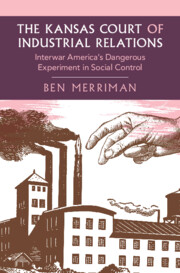Refine search
Actions for selected content:
47 results

Labor Unions and Democratic Unrest in North Africa
- Protest and Resistance in Tunisia and Morocco
-
- Published online:
- 20 November 2025
- Print publication:
- 20 November 2025
1 - Introduction
-
- Book:
- Labor Unions and Democratic Unrest in North Africa
- Published online:
- 20 November 2025
- Print publication:
- 20 November 2025, pp 1-20
-
- Chapter
- Export citation

Money, Partisanship and Power in Local Politics
-
- Published online:
- 03 November 2025
- Print publication:
- 04 December 2025
-
- Element
- Export citation
8 - Competing Stories of Self-Help Before 1936
-
- Book:
- Self-Made
- Published online:
- 30 October 2025
- Print publication:
- 30 October 2025, pp 181-205
-
- Chapter
- Export citation
Laboring Liberation: The Jerusalem Electricity Company Workers’ Strike of 1979
-
- Journal:
- International Labor and Working-Class History , First View
- Published online by Cambridge University Press:
- 16 October 2025, pp. 1-7
-
- Article
-
- You have access
- Open access
- HTML
- Export citation
4 - The Lost Legal Promise and Political Failings of the KCIR
- from Part I - The KCIR in Kansas
-
- Book:
- The Kansas Court of Industrial Relations
- Published online:
- 26 July 2025
- Print publication:
- 14 August 2025, pp 88-118
-
- Chapter
- Export citation
Afterword
- from Part II - The KCIR in the World
-
- Book:
- The Kansas Court of Industrial Relations
- Published online:
- 26 July 2025
- Print publication:
- 14 August 2025, pp 218-236
-
- Chapter
- Export citation
7 - The Politics of TPP and TTIP in the United States
-
- Book:
- Every Firm for Itself
- Published online:
- 21 July 2025
- Print publication:
- 07 August 2025, pp 139-169
-
- Chapter
- Export citation
3 - The Domestic Politics of Intra-Industry Trade: A Theoretical Model
-
- Book:
- Every Firm for Itself
- Published online:
- 21 July 2025
- Print publication:
- 07 August 2025, pp 40-59
-
- Chapter
- Export citation

The Kansas Court of Industrial Relations
- Interwar America's Dangerous Experiment in Social Control
-
- Published online:
- 26 July 2025
- Print publication:
- 14 August 2025
Voices of Sanitation Workers in Japan amidst the COVID-19 Pandemic
-
- Journal:
- Asia-Pacific Journal / Volume 18 / Issue 18 / September 2020
- Published online by Cambridge University Press:
- 14 March 2025, e15
-
- Article
-
- You have access
- Open access
- Export citation
Workers and Democracy: The Indonesian Labor Movement, 1949–1957
-
- Journal:
- Asia-Pacific Journal / Volume 20 / Issue 18 / October 2022
- Published online by Cambridge University Press:
- 14 March 2025, e7
-
- Article
-
- You have access
- Open access
- Export citation
Labor Union Membership and Women’s Political Ambition: Evidence from the United States
-
- Journal:
- Politics & Gender / Volume 21 / Issue 2 / June 2025
- Published online by Cambridge University Press:
- 07 January 2025, pp. 220-245
-
- Article
-
- You have access
- Open access
- HTML
- Export citation
9 - The All-Affected Principle and Labor Rights
- from Part III - Taming Economic Power
-
-
- Book:
- Empowering Affected Interests
- Published online:
- 14 November 2024
- Print publication:
- 14 November 2024, pp 161-176
-
- Chapter
-
- You have access
- Open access
- HTML
- Export citation
2 - How Union Organizations Shape Teacher Mobilization
-
- Book:
- Mobilizing Teachers
- Published online:
- 16 May 2024
- Print publication:
- 23 May 2024, pp 13-34
-
- Chapter
- Export citation
4 - Organizational Consolidation in Mexico
-
- Book:
- Mobilizing Teachers
- Published online:
- 16 May 2024
- Print publication:
- 23 May 2024, pp 70-88
-
- Chapter
- Export citation
10 - Teacher Politics in Comparative Perspective
-
- Book:
- Mobilizing Teachers
- Published online:
- 16 May 2024
- Print publication:
- 23 May 2024, pp 192-218
-
- Chapter
- Export citation
8 - Factionalism in Colombia
-
- Book:
- Mobilizing Teachers
- Published online:
- 16 May 2024
- Print publication:
- 23 May 2024, pp 153-170
-
- Chapter
- Export citation
1 - Why Teachers?
-
- Book:
- Mobilizing Teachers
- Published online:
- 16 May 2024
- Print publication:
- 23 May 2024, pp 1-12
-
- Chapter
- Export citation
6 - Organizational Weakening in Argentina
-
- Book:
- Mobilizing Teachers
- Published online:
- 16 May 2024
- Print publication:
- 23 May 2024, pp 111-130
-
- Chapter
- Export citation
